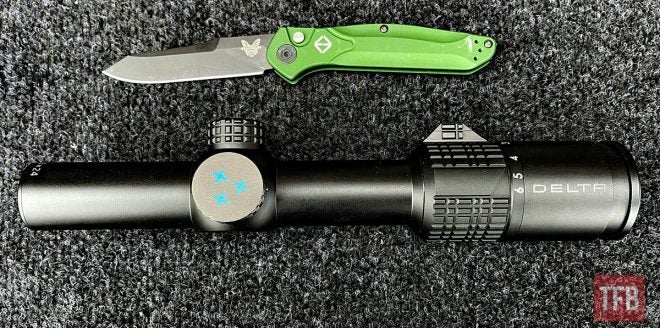Today we’re going to look closer at Delta Optical and their Hornet 1-6×24 SFP Riflescopes. It’s no secret that LPVOs (Low Power Variable Optics), have become very popular among sports shooters, hunters and even various armies or special units. The name refers to a riflescope with a magnification range that starts around 1x on the low end. The highest magnification is generally 4x, 6x, 8x up to 10x and sometimes even beyond that. In terms of price, they can be fairly cheap, like this Delta Hornet, up to high-end costing almost ten times more. This review actually includes two riflescopes, one with the D2MR reticle and one with D2BR. I don’t know when the Hornet was released, but I think it has been on the market for about 2 years.
LPVO Reviews @ TFB:
- Schmidt & Bender 1-8×24 PM II ShortDot Dual CC (FFP)
- Kahles K18i Riflescope with IPSC Reticle (incl. Comparison)
- Vortex Razor HD GEN III 1-10×24 (FFP)
- Vortex Strike Eagle 1-6×24 AR
- Vortex Razor HD 1-6X24 Gen II-E
In a series of reviews, we’re going to look at the following LPVO riflescopes: Athlon BTR Gen2 1-8×24, Athlon BTR Gen2 1-10×28, Delta Optical Hornet 1-6×24 SFP (this one), Delta Optical Stryker HD 1-6×24 SFP and Sightmark Citadel 1-10×24 HDR.

Two Delta Optical Hornet 1-6×24 Riflescopes. The knife is from Microtech, to add some color.
Reference Riflescope:
Since I have years of experience with the Swarovski Z6i 1-6×24 from IPSC Rifle shooting competitions (and some hunting), this is going to be our reference scope. The model has been around for a long and is well-known as a premium optic. I also use the Zeiss V8 1.1-8×30 which is my first choice nowadays, but in terms of size (24-28 mm vs 30 mm tube), the Swarovski works better as a reference. The reference scope used here is a Gen 1, bought 2nd hand, and more than 8 years old. In the USA, the latest Z6i Gen 2 sells for around $2,410.00 (Source).
About Delta Optical:
Delta Optical was founded in 2002 in Poland and have expanded quickly into Europe. To my knowledge, this is Delta’s first appearance on TFB. As a brand, they have a reputation of being affordable and made with quality, and there are plenty of discussions about the brand on various forums. It’s no secret that their business model is to find suppliers in Japan, China and other Asian OEM manufacturers. You can also find the brand in the USA.
Made In?
The Delta Optical Hornet 1-6×24 tested here is made in the Philippines. The Delta Stryker HD we’re about to review is made in Japan, so make sure you check your facts if this is of interest.
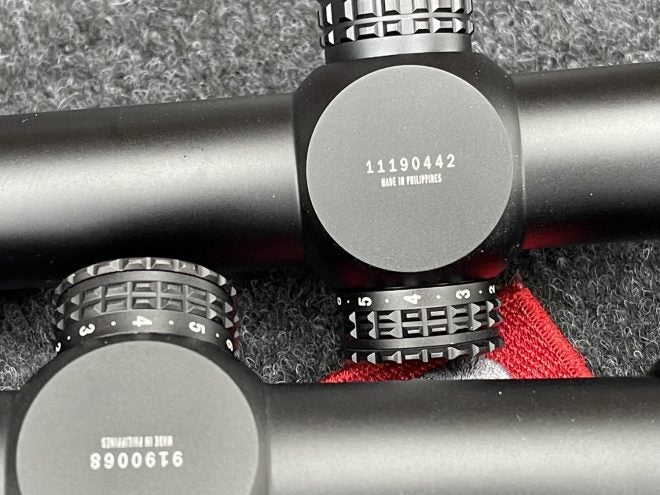
Ergonomics:
The design is pretty basic with black surface finishing. The three protruding turrets are more or less of the same design. The turrets for height and windage are covered and you have to unscrew the caps to get access to the adjustment. The clicks work, but they are “mushy” and indistinct. This is probably the biggest disappointment with the Hornet.
LPVOs aren’t generally the type of scopes that you would dial anyway, but I sometimes do it between 100 or 300 meters, in competitions (re-adjust my zero if a lot or all targets are at one distance).
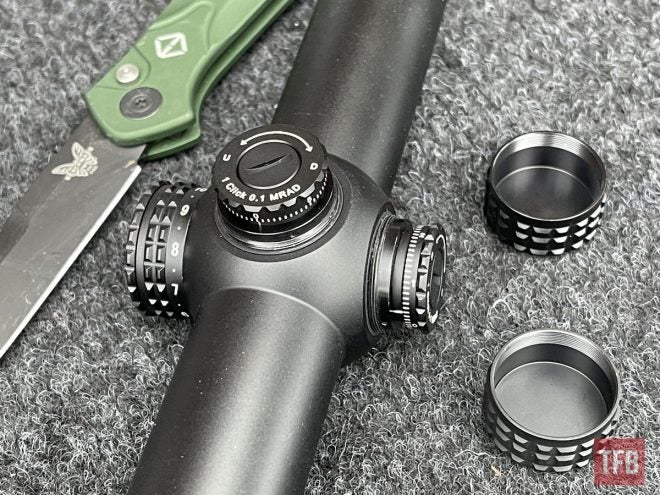
The illumination can be set from 1 to 10, and every other setting is “off”. It does take a little bit of force to move it, but the texture provides good friction. The magnification lever goes from 1 to 6 and has a short but very useable throw lever, and the feeling and strength needed feel just fine.
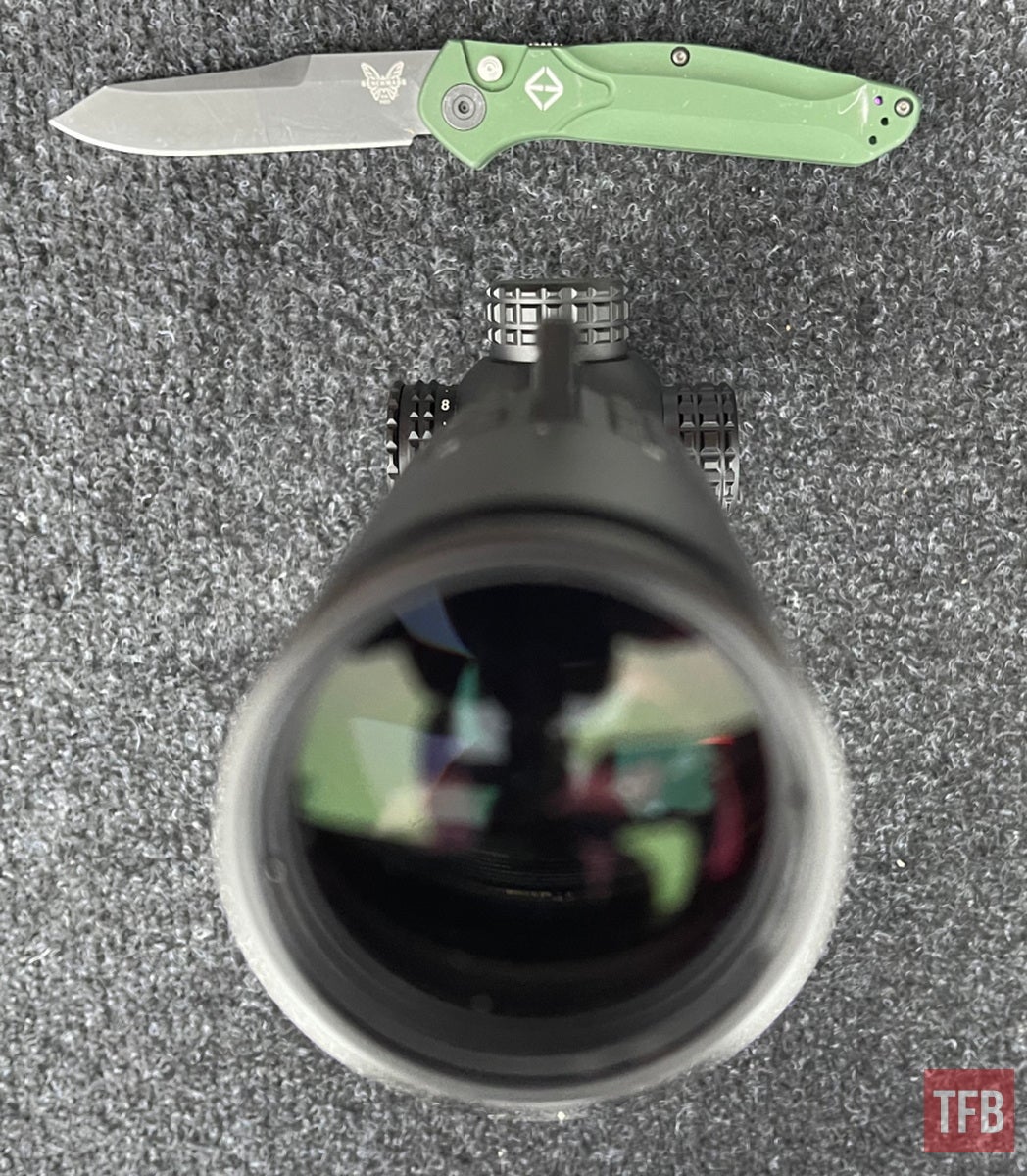
I do like the black “stealth” look of the Delta logotype and the blue Delta logo stands out rather nicely. All the letters, numbers and markings are clearly visible. As you can see we had two of these Hornets. One had a throw lever that felt just perfect, the other was much harder to move.
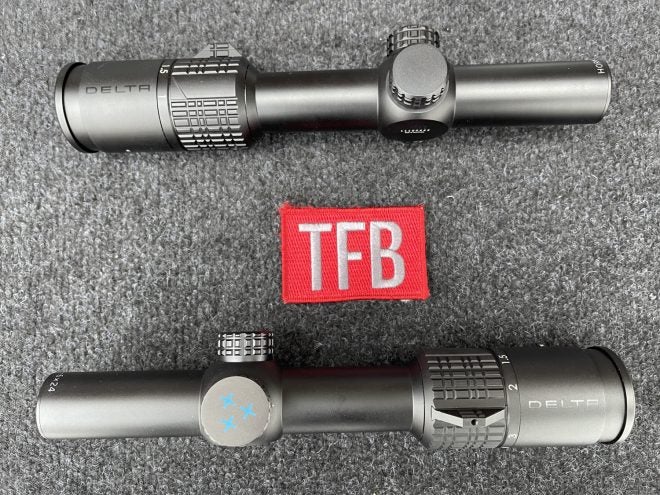
For comparison, you can see the Delta Optical Hornet 1-6×24 (center) versus the Swarovski Z6i 1-6×24 (top) and the Vortex Strike Eagle 1-8×26 (bottom). The mounts are from Spuhr. You may notice that the Delta is smaller than the others.

Top view. The knife is a 9400 Auto Osborne by Benchmade.

Side view.
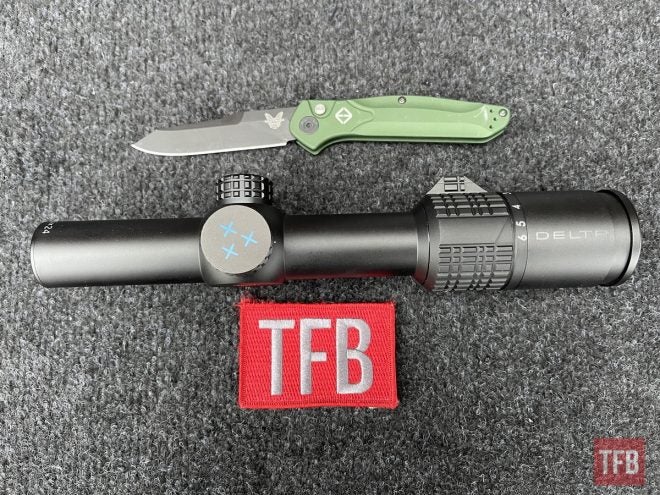

Reticles & Illumination:
Apart from the overall optical performance of a riflescope, reticles mean a lot. I’ve seen good optics ruined by poor reticle design. Typically they’ll give too much information in moments you need very little. Just remember that my preference in reticles may be different from yours, and what you are going to use it for.
You can choose between the D2MR and the D2BR reticles. The D2BR is a horseshoe reticle with a Christmas tree below. For IPSC/3-Gun my choice would be the D2MR reticle.
Please note that the reticles are both second focal plane, so they stay the same size regardless of magnification. I don’t know why Delta Optical provided these images as they kind of indicate the reticle is FFP, which they are not. Consider the right illustration as a zoomed-in image of the reticle only.
 For elevation, there’s 44 MRAD / 151 MOA of adjustment. The maximum field of view is 35.7m at 100 meters.
For elevation, there’s 44 MRAD / 151 MOA of adjustment. The maximum field of view is 35.7m at 100 meters.

The illumination on the Hornets isn’t bad, but I wouldn’t call them daylight bright. If this is a big deal, you should check out the Delta Stryker HD instead, which is better but also more expensive. The horseshoe in the D2BR makes that reticle appear brighter since there’s more red reflection. In comparison, the Swarowski provides a much brighter, useable dot. The question is, is it that important to you? Quite often you get a good contrast versus the target anyway.
We have not tested if the scope tracks, as this is usually not the type of sight that you adjust in every stage.
Optical performance:
It seems that a lot of producers of LPVOs have learned and developed quite a lot over recent years, these Delta Hornets are actually quite good. The magnification is around 1x, and you can work with the ocular as well to get a true unmagnified image. The image feels flat enough and there isn’t much blur even in the outer ring of the glass. The field of view is a little less than the Swarovski, but we’re talking trivials here. Mostly the performance is reasonable and satisfying. In terms of eye relief and eye-box, I don’t really have any complaints either. The tube appears thicker than Swarovski’s, which is another negative.

It always amazes me how good the Swarovski Z6i is, it’s like a Full HD enhanced image of the reality around you. Light transmission is also a bit better, and the colors are more natural. This reference scope is about 10 years old and it’s still on top of things, but the low-cost competition got a lot closer now. Hint: don’t use a reference scope and benchmark side-by-side, just be happy with what you can afford.
Hold on, here we go with a multitude of examples.
Delta Hornet at 1x.

Delta Hornet on 1x, this is how it appears. Note that depending on how you hold the camera you get more or almost no tunneling effect.
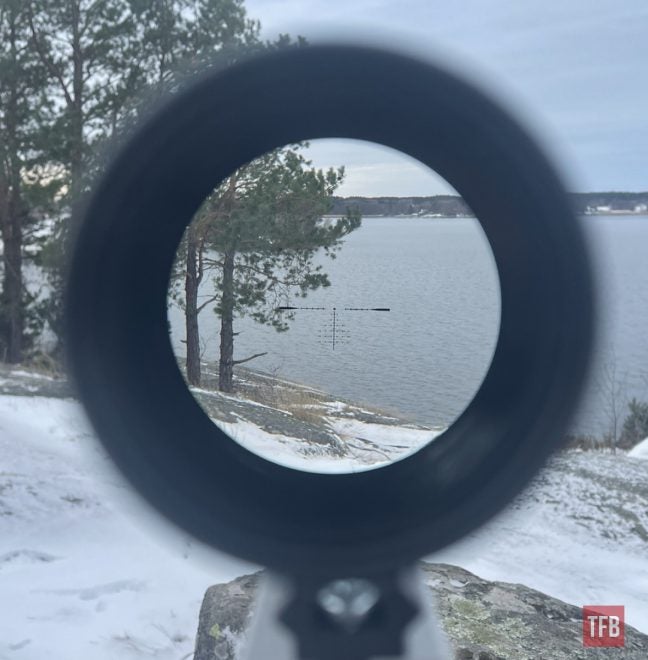
Swarovski Z6i (Gen 1) 1x to compare. There are several different reticles for the Z6i.

Swarovski Z6i (Gen 1). This is the hunting reticle. For IPSC, I prefer LD-I or BRT-I.
Delta Hornet 3x
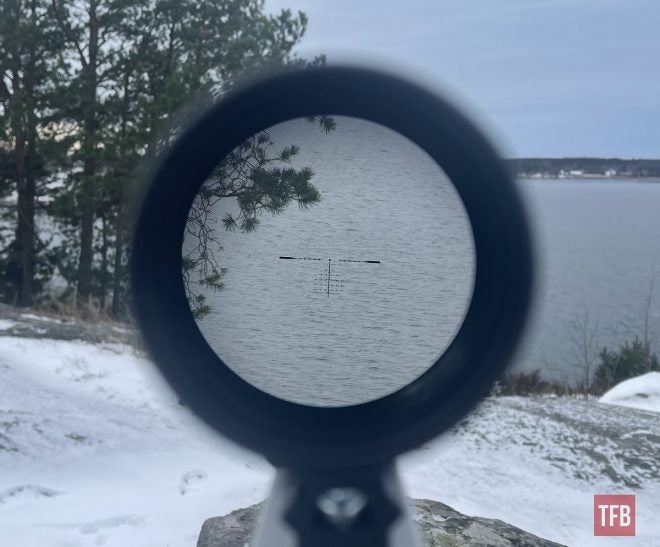
Delta Hornet 6x, 650 meters.

Swarovski Z6i (Gen 1) 1x, 650 meters. Notice the difference in field of view between the two, and how thick/thin the walls of the tubes appear. The Delta is not bad at all, but you get what you pay for with the Swarovski.

Swarovski Z6i (Gen 1)
Delta Hornet 6x, 450 meters.
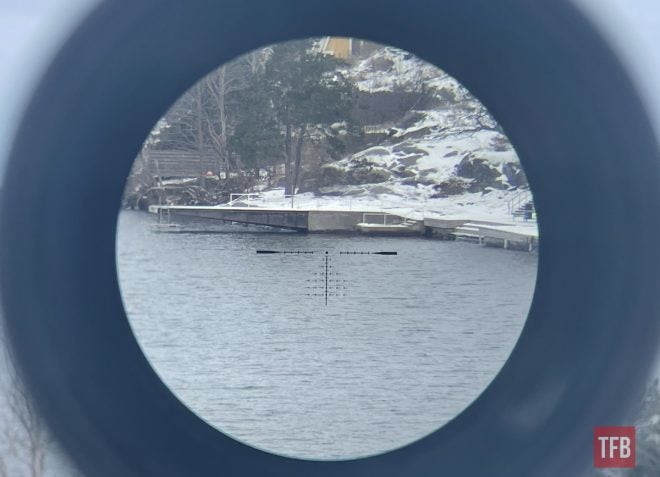
Swarovski Z6i (Gen 1) 6x.450 meters.
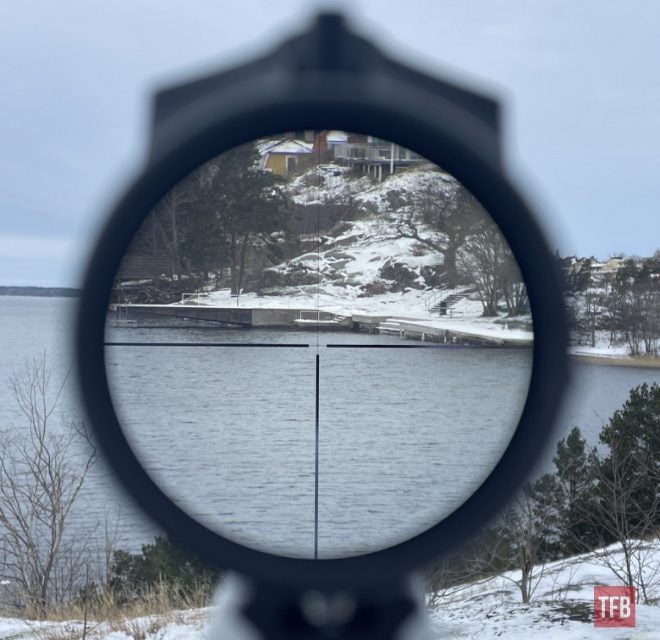
Swarovski Z6i (Gen 1)
Delta Hornet 6x, 1850 meters.

Thermal Imaging Front Attachments:
Since we had access to the Pulsar Proton FXQ30 thermal clip-on, it would be wrong not to demonstrate this capability. This gives a new dimension to LPVOs, especially for hunters, since these scopes aren’t really famous for their low-light capabilities. But a lot of hunters use them for the driven hunt. If you have a similar night vision device, you can of course mount this as well, and continue the hunt when the sun sets. In an SHTF scenario, I’m pretty sure this added capability wouldn’t hurt either.
You need an adapter for the thermal to fit the end of the 30 mm tube of the riflescope. In this case, we used the Rusan 30mm adapter for the Pulsar Krypton and Proton thermal clip-ons. Below you can see what it looks like. All you need is a mount for the scope and you are good to go as long as the Rusan goes clear under your rail. It doesn’t add a lot of space, so this setup should work for most rifles.

Delta Hornet with Rusan 30 mm adapter and Pulsar Proton FXQ30 thermal clip-on. Sweet solution!
Below: Here is a wolf (yes, a real one, although in captivity) with a thermal still photo from the Pulsar Krypton, white hot. This is from a wildlife park, so the device was hand-held. The Pulsar Krypton might work as well, but it would add more bulk and weight. Cloudy/rainy day, +12C, summer in the Grim North.

Below: The mounts are Spuhr SCP-3000 (Slim/Hunting line) and Spuhr SP-3002 (Hornet).

Picture taken into the Hornet on about 1.5x with the Proton mounted, at the same time as the reticle photos above. The concrete bridge is mid-left. Winter, -6C. Daytime ruins the contrast, but the picture was taken for demo so you can learn about the possibilities. If there is a thermal signal you will see it. A dog at 450 meters is not a problem. Note that you’re using the main reticle of the scope, the Proton doesn’t have a reticle. Since you’re zooming into the screen of the Proton there are limits to how far you can zoom, within 1.5-4x is optimal.
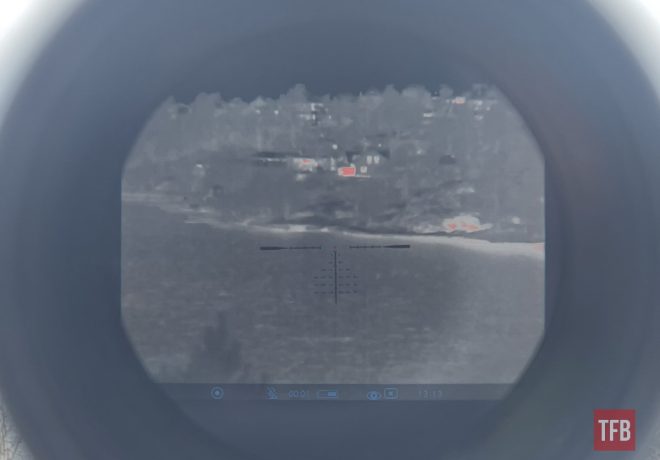
NOTE: Nothing here is mounted on a firearm, just for demonstration purposes.
Pricing:
TFB normally only quotes the suggested retail price, and here it gets a little tricky as we don’t have this figure for any of the markets. In Europe, the price seems to be around €399. In the USA it seems it retails in the region $350-$400. You do get a good entry-level scope for that money with the Hornet.
The MSRP for the Swarovski Z6i Gen2 is $2,410. (Source)
Conclusion:
A lot of people may not be able to afford the best and branded high-end optics, and a few would rather spend the change on the gun, accessories or ammunition. The Delta Hornet is quite an affordable option, and you’re not risking a lot of money. There are red dots that are more expensive, but I think the Hornet will give you a much better shooting experience. You can reach out to 300 meters comfortably, beyond that it works of course but LPVOs are mainly made for close-to-mid-range solutions. In other words, if you use it for long range, your bullets may not arrive in a nice group on the target, and that is mainly down to the reticle and the lack of high magnification (never ever blame your own shooting).
I have to admit that I was skeptical about the Hornet (and “cheap” riflescopes in general), but I’m also willing to admit when I’m wrong. I’m not a huge fan of any of the reticle options, but it’s a matter of personal choice. Looking at the optical performance and overall package, I would say that I had expected the price to be a little higher.
We’re always interested in feedback. Please use the comments section and tell us what you think about the review and the Delta Optical Hornet 1-6×24 scope. We will continue publishing reviews of more LPVOs in the near future.
 Your Privacy Choices
Your Privacy Choices
